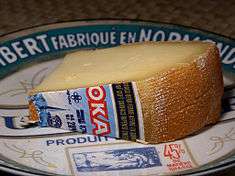Canadian cheese
Cheese has been produced in Canada since Samuel de Champlain brought cows from Normandy in either 1608 or 1610,[1] The Canadienne breed of cattle is thought to descend from these and other early Norman imports. New France developed soft, unripened cheeses characteristic of its metropole, France. Later British settlers and Loyalists fleeing the American Revolution introduced British styles such as cheddar.[2]

 |
| Part of a series on |
| Canadian cuisine |
|---|
|
Regional cuisines |
|
Ingredients |
|
Styles and dishes
|
|
Religious and ethnic
|
|
Rituals and festivals
|
|

History
Canadian cheeses were almost entirely farm-made until 1864 when an American, Harvey Farrington started buying Canadian milk in commercial quantities necessary for industrial cheese making. The first commercial factory "The Pioneer" was set up in Norwich, Ontario, in 1864.[2]
Following a wheat midge outbreak in Canada in the mid-nineteenth century, farmers in the province of Ontario began to convert to dairy farming in large numbers, and cheddar cheese was their main exportable product (before electric refrigeration was invented), even being exported back to the cheese's country of origin, England. In one year, 1867, the year of Canadian Confederation, 200 cheese factories were established in Ontario alone.[2] In 1881, Édouard-André Barnard created North America's first cheese-making school in Saint-Denis-De La Bouteillerie, Québec. A dairy school (Canada's first) opened in 1892 in Saint-Hyacinthe, Québec, and in 1901 produced experimental Canadian versions of Camembert and Feta.[2] By the turn of the twentieth century there were 1,242 cheddar factories in Ontario, and cheddar had become Canada's second largest export behind timber.[1] Cheddar exports totalled 234,000,000 pounds (106,000,000 kg) in 1904, but by 2012, Canada was a net importer of cheese, and a manufactured cheese product "Kraft Dinner" macaroni and cheese had become Canada's most popular grocery product and de facto national dish. James Lewis Kraft grew up on a dairy farm in Ontario, before moving to Chicago. As writer Sarah Champman writes, "Although we cannot wholly lay the decline of cheese craft in Canada at the feet of James Lewis Kraft, it did correspond with the rise of Kraft's processed cheese empire."[1]
Contemporary cheese production
Canadian cheeses are classified into six categories per their moisture content, which are firm, soft, semi-soft, fresh, blue-veined and hard, with most cheeses being classified as firm, soft, or semi-soft.[3] Canada presently produces over 1,050 varieties and brands of cheese.[3] More than half of the cheese manufacturers are located in Québec.[3] The Sélection Caseus is an annual contest for Québec cheeses that began in 1999. It awards gold, silver and bronze prizes each year as well as prizes in diverse categories.[4]
See also
References
- Chapman, Sasha (September 2012). "Manufacturing Taste". The Walrus. Archived from the original on January 5, 2013. Retrieved September 1, 2012.
- Dairy Farmers of Canada. "Cheese". Retrieved 7 January 2016.
- Canadian Cheese Directory. Canadian Dairy Information Centre, Government of Canada.
- Ministère d'Agriculture, des Pécheries et de l'Alimentation du Québec. "Sélection Caseus".
Further reading
- Canadian Cheese.
- The Definitive Canadian Wine and Cheese Cookbook.
- The competitiveness of Canada's cheese manufacturing plants - a benchmarking analysis.
- Variety Cheese in Canada.
- Compositional Standards for Cheese in Canada.
- The Complete Idiot's Guide to Cheeses of the World. pp. 192–. (subscription required)
- "I Went to the Oscars of Canadian Cheese". Vice.
- "Canadian blue cheese from Ontario wins Best in Show". The Globe and Mail.
- "Fayrefield Foods wins Best Canadian Cheese in international competition". CTV News.
- "This Canadian cheese named best in the world". The Globe and Mail.
- "America, Your Favorite Cheese Is Canadian". Vice.